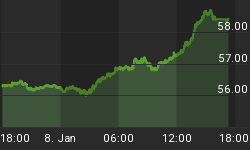Gold prices have mostly been treading water since Wednesday after the Fed announced another .25 percent rate hike in benchmark interest rates to 0.75-2 percent. The move was largely anticipated by gold punters, and gold managed to make modest gains before moving slightly below the $1,300-an-ounce level in electronic trading at the close.
The Fed said its decision came against a backdrop of a strengthening economy and an improving labor market.
The central bank also signaled two more hikes for 2018, which will bring the total for the year to five, the most in the current cycle. Interest rates are now at their highest since the 2008 financial crisis, although the benchmark rate remains considerably lower than the historical average.
That should definitely be hawkish for gold. Yet, prices opened Thursday trading with strongly bullish momentum: The price per ounce increased more than $10 at one point to nearly $1,310.

(Click to enlarge)
Source: Investing.com
The current gold rally runs contrary to the normal pattern observed since the Fed first took a stab at rate hikes in December 2015.
So what's happening here?
There are two plausible explanations:
The first is simply a classic case of 'buy the rumor sell the news,' or more accurately an inversion of the adage. The June hike was largely anticipated and gold traded down to reflect that. When the rumor finally became reality, the yellow metal reversed the trend.
The second is a bit more nuanced--and has to do with the interest rates the Fed pays to banks on excess reserves.
The committee said nothing about excess reserves in the customary post-FOMC meeting. The Fed chairman waited until the tail-end of his press conference before announcing a hike in Fed fund rates for excess reserves by just five basis points to 0.25 percent. That sent out the message to the markets that the Fed was trying to incentivize commercial banks to draw down their excess cash parked at the central bank and lend it into the economy.
In other words, the Fed appears interested in stimulating money supply, which will increase inflation, which in turn is likely to push gold prices up.
Related: Gold Could Head Lower In Coming Weeks
The markets reacted immediately to that announcement, with gold heading north by about 0.3 percent; silver climbing 1.3 percent, while the dollar and stocks plummeted. Meanwhile, the 10-year Treasury yield retreated from over three percent to 2.97 percent.

(Click to enlarge)
Source: USA Gold
The Fed only started legally paying interest rates on excess reserves in 2008. By controlling the rates it pays to banks, it can regulate the money supply to either induce inflation in an overheating economy or lower inflation to jumpstart a lagging one.
Gold Remains Its Own Bogeyman
In the short time that it has taken to write this article, gold's technical analysis charts have gone from this:

(Click to enlarge)
.. to this:

Source: Investing.com
...because of this:

(Click to enlarge)
Source: Bloomberg
So gold has basically gone from a Strong Buy to a merely a Buy in a matter of hours all thanks to a surging dollar. The price has started breaching the short-term 5-day and 10-day moving averages but still remains above the long-term moving averages.
And that comes as no surprise to anyone who has been following the pair in recent times.
Gold has become gold's biggest bogeyman, and is likely to remain so in the near future. So place your bets accordingly.
By Alex Kimani for Safehaven.com
More Top Reads From Safehaven.com:

















